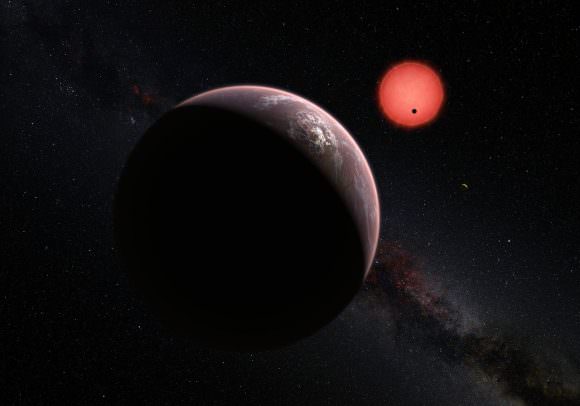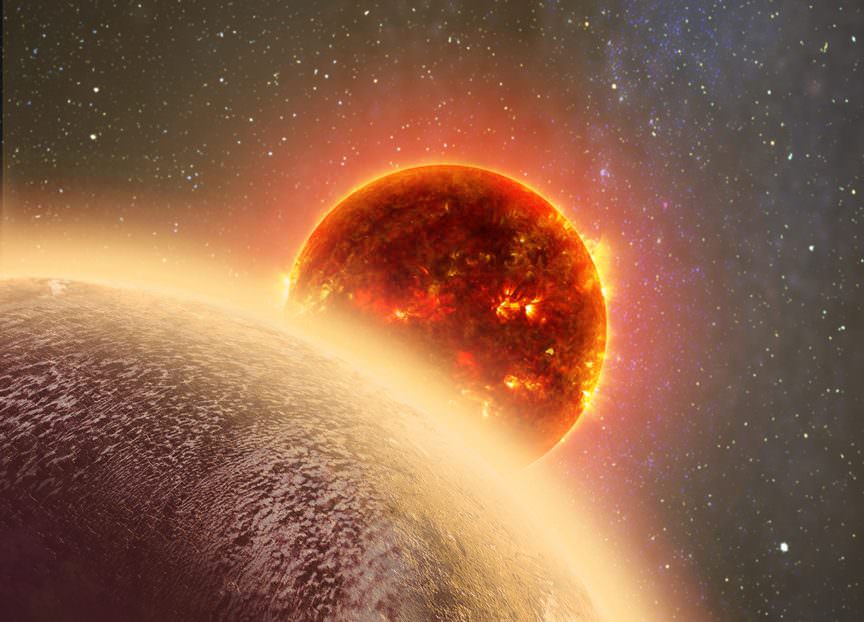Last year, astronomers discovered a terrestrial exoplanet orbiting GJ 1132, a red dwarf star located just 12 parsecs (39 light years) away from Earth. Though too close to its parent star to be anything other than extremely hot, astronomers were intrigued to note that it appeared to still be cool enough to have an atmosphere. This was quite exciting, as it represented numerous opportunities for research.
In essence, the planet appeared to be “Venus-like” – i.e. very hot, but still in possession of an atmosphere. What’s more, it was close enough to our Solar System that its atmosphere could be studied in detail. However, a debate began over whether its atmosphere would be hot and wet, or thin and tenuous. And after a year of study, a team of astronomers from the CfA believe they have unlocked that mystery.
In addition to being relatively close to our own Solar System in astronomical terms, the Venus-like exoplanet GJ 1132b also has a relatively small orbital period around its star. This means that opportunities to spot it as it passes in front of its star (i.e. the Transit Method), occur quite often.

This makes it an excellent target for detailed observation and study, which in turn will help astronomers to learn more about terrestrial exoplanets that orbit close to red dwarf stars. But as noted already, astronomers were divided on the issue of GJ 1132b’s atmosphere.
Thanks to the research efforts of Laura Schaefer and her colleagues from the Harvard-Smithsonian Center for Astrophysics (CfA), it now appears that the case for a thin atmosphere is the far more likely. Interestingly enough, this was confirmed by determining just how much oxygen the planet has in its atmosphere.
For the sake of their study, which was outlined in a paper that approved for publication in The Astrophysical Journal – titled “Predictions of the atmospheric composition of GJ 1132b” – they explain how they used a “magma ocean-atmosphere” model to determine what would happen to GJ 1132b over time if it began with a water-rich atmosphere.
They began with the knowledge that a planet like GJ 1132b – which orbits its star at a distance of 2.25 million km (1.4 million mi) – would be subjected to intense amounts of ultraviolet light. This would result in any water vapor in the atmosphere being broken down into hydrogen and oxygen (a process known as photolysis), with the hydrogen escaping into space and the oxygen being retained.
![Comparison of best-fit size of the exoplanet GJ 1132 b with the Solar System planet Earth, as reported in the Open Exoplanet Catalogue[1] as of 2015-11-14. Open Exoplanet Catalogue (2015-11-14). Retrieved on 2015-11-14. Aldaron, a.k.a. Aldaro](https://www.universetoday.com/wp-content/uploads/2016/08/Exoplanet_Comparison_GJ_1132_b-e1471628608145-580x319.png)
They concluded that the planet’s magma ocean would absorb about one-tenth of the oxygen in the atmosphere. The majority of the remaining 90 percent, according to their model, would be lost to space while a small margin would linger around the planet. This proved to be very much consistent with measurements made of the planet thus far.
As Dr. Laura Schaefer explained to Universe Today via email:
“We determined that the planet would likely have a thin atmosphere by doing a suite of models looking at atmospheric loss and interaction with a surface magma ocean. For the allowable composition range (esp. the abundance of water) based on the current mass measurement, nearly all of the allowed compositions resulted in thin atmospheres, except at the very extreme upper end of the range.”
This magma ocean-atmosphere model could not only help scientists to study terrestrial exoplanets that orbit close to their parent stars, but also to understand how our own planet Venus came to be. For some time, scientists have theorized that Venus began with significant amounts of water on its surface, but that it then underwent a significant change.

This ocean is believed to have evaporated due to Venus’ closer proximity to the Sun, with the ensuing water vapor triggering a runaway greenhouse effect. Over time, ultraviolet radiation from the Sun broke apart the water molecules, resulting in the hot, virtually waterless atmosphere we see today. However, what happened to all the oxygen has remained a mystery.
“We also have plans to use this model in the future to study Venus, which may have once had about the same amount of water as the Earth but is now very dry,” said Schaefer. “There is very little O2 left in Venus’ atmosphere, so this model would help us understand what happened to that oxygen (whether it was lost to space or absorbed by the planet’s mantle).”
Schaefer predicts that their model will also assist researchers with the study of other, similar exoplanets. One example is the TRAPPIST-1 system, which contains three planets that may lie with the star’s the habitable zone. But as Schaefer put it, the real value lies in the fact that we are more likely to find “Venus-like” worlds down the road:
“Most of the rocky planets that we know of and will discover in the near future will likely be hotter than the Earth or even Venus, just because it is easier to detect hotter planets. So there are a lot of planets out there similar to GJ 1132b just waiting to be studied!”
Headquartered in Cambridge, Mass., the Harvard-Smithsonian Center for Astrophysics (CfA) is a joint collaboration between the Smithsonian Astrophysical Observatory and the Harvard College Observatory. It’s scientists are dedicated to studying the origin, evolution and future of the universe.
And be sure to check out this video, courtesy of MIT news:

